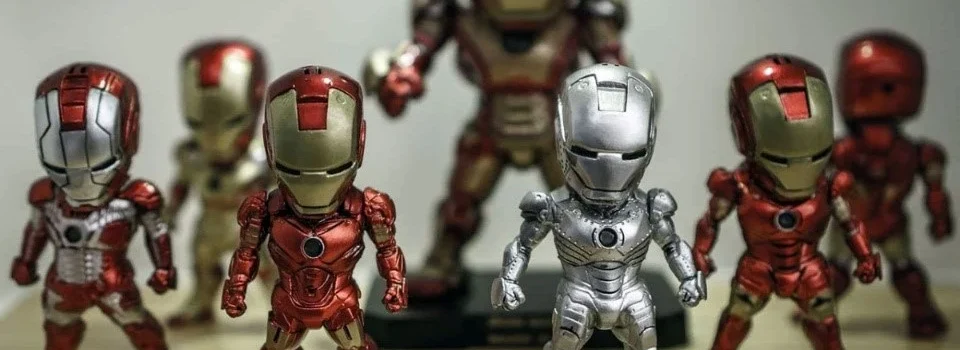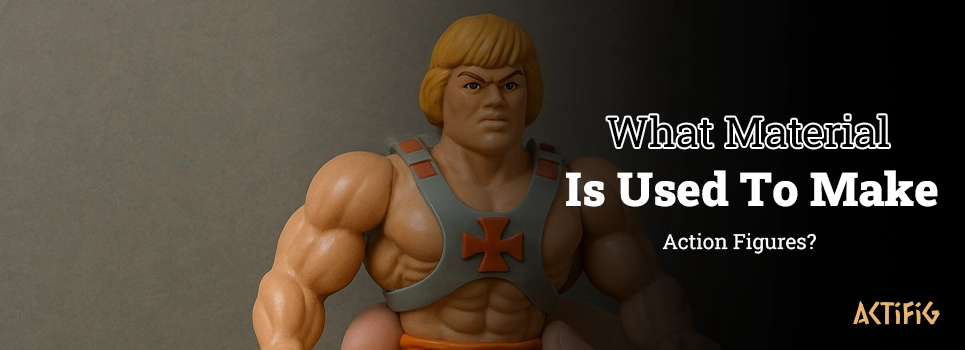No products in the cart.
Choosing the right action figure materials is crucial for both durability and quality. Therefore, in this article, we will explore different materials used in their production. These include plastics, resins, and specific metals.
Since each material has unique properties, it directly affects an action figure’s appearance and strength. For instance, strong plastics like ABS create sturdy models. However, resins allow for intricate details due to their flexibility. Therefore, selecting the right material depends on the figure’s design and purpose.
In this discussion, we will examine not only these materials but also their impact on final product quality. Additionally, we will explain how manufacturers incorporate them into figure design. Moreover, we will discuss the advantages and disadvantages of each material.
What Is an Action Figure?
An action figure is a movable statue representing characters from movies, comics, video games, and anime. Many of these figures have articulated joints. Therefore, collectors can pose them in various positions. This feature distinguishes action figures from static display models.
Most action figures are made from high-quality plastics. However, some exclusive editions use metal or resin. Action figure materials significantly influence details and overall quality. Manufacturers apply specialized paints to ensure a realistic and durable look. Since these figures are handled frequently, the paint must resist scratches and UV exposure.
Action figures come in different sizes. Some are small and ideal for desk displays. However, others are larger and feature more intricate details. Well-known brands like Hot Toys, McFarlane, and Bandai create highly detailed collectibles. Since fans value accuracy, they are willing to pay more for premium models.


The Importance of Materials in Action Figures
Selecting the right action figure materials requires careful consideration. Since materials impact flexibility and durability, they determine a figure’s longevity. Some figures include accessories like weapons, outfits, and stands. Therefore, combining quality materials with precise craftsmanship enhances their value.
Today, many people collect action figures for various reasons. Some buy them for display in glass cases. However, others use them for photography or creative scene-building. Action figure materials, along with design and brand reputation, are key factors in purchasing decisions.
10 Top WWE Action Figures to Collect in 2025
Read articleTypes of Action Figure Materials
Action figure materials play a crucial role in quality, detail, and durability. Since different materials offer unique benefits, collectors, and manufacturers must understand their properties. Therefore, this article explores the most common materials used in action figure production.
1. Hard Plastic (ABS & PVC)
Hard plastic is one of the most popular action figure materials. Since it is affordable and easy to mold, many figures are made from it. However, each type has distinct characteristics.
- ABS: This plastic provides excellent durability. Therefore, it is ideal for parts that need extra strength. Additionally, its smooth and glossy surface enhances fine details.
- PVC: This material is more flexible than ABS. Therefore, it is often used for clothing, soft parts, and accessories. However, it is sensitive to heat and may deform over time.
- ABS + PVC Combination: Some manufacturers blend both materials for better performance. Therefore, figures gain both durability and flexibility.
2. Resin
Resin is another widely used action figure material. Since it allows for intricate details, it is preferred for high-end collectible figures.
- Polyester Resin: This type is highly durable. Therefore, it is perfect for static and decorative figures. However, it is brittle and breaks easily upon impact.
- Polyurethane Resin: This variation offers more flexibility. Therefore, some manufacturers use it for figures with finer details.
- Advantages of Resin: This material allows for precise molding and detailed painting. However, it is more expensive than plastic.
3. Metal (Die-Cast)
Metal is one of the rarest action figure materials. Since it offers superior strength, it gives figures a more premium feel.
- Zinc & Aluminum Alloys: These materials enhance durability. Therefore, some figures feature metal parts, such as internal skeletons, for extra support.
- Heavier Weight: Metal figures feel more substantial. Therefore, they often seem higher in quality. However, their weight makes transportation more challenging.
- High Durability: Metal resists impact better than plastic. Therefore, it lasts longer. However, production costs are significantly higher.
4. Silicone and Rubber
Some action figure materials simulate skin texture or clothing. Therefore, manufacturers use soft materials like silicone and rubber.
- Silicone: This material is highly flexible. Therefore, it is ideal for creating more natural facial features and thinner clothing.
- Soft Rubber: Some joints and parts requiring movement are made from rubber. This is because it resists bending and maintains durability.
- Durability and Issues: Over time, these materials degrade. Therefore, proper care is essential to prevent cracks and damage.
What is the action figure creation process?
Read article5. Fiberglass and Polystone
Some action figure materials are used for exclusive collector’s editions. Therefore, materials like fiberglass and polystone are chosen.
- Fiberglass: This material is lightweight yet strong. Therefore, it is used for crafting large or custom statues.
- Polystone: This composite blends synthetic stone with resin. Therefore, it gives action figures a premium and heavier feel.
- Pros and Cons: These materials are highly durable. However, they are costly to produce and significantly increase the figure’s weight.
The Impact of Paint Type on Action Figure Materials
Different paints have unique properties. Therefore, selecting the right type of paint is crucial for action figure materials. Some paints resist environmental conditions well. However, others degrade quickly.
- Acrylic Paints: These paints provide an even coat. Therefore, they are ideal for detailing action figure materials.
- Oil-Based Paints: These paints last longer. However, they take more time to dry and are harder to apply.
- Metallic Paints: Some action figure materials require a metallic finish. This is because it creates a glossy and realistic effect.
- Matte and Semi-Matte Paints: These paints enhance natural textures in action figures. Therefore, they are commonly used in collector’s editions.
- Light Exposure: Certain paints are sensitive to sunlight. Therefore, they may fade and lose their original quality over time.
- Paint Durability: Some action figure materials are painted with low-quality coatings. Therefore, their color may peel off as time passes.
Choosing the right paint enhances action figure material quality. Therefore, manufacturers must use durable and high-quality paints.


How to Identify High-Quality Materials in Action Figures
The materials used in an action figure play a crucial role in its durability and overall quality. Therefore, understanding the characteristics of premium materials is essential for choosing the best figure. The components directly impact both the details and strength of the product.
One way to recognize high-quality materials is by checking the figure’s weight. Well-made action figures usually have a balanced weight and are neither too light nor too heavy. Therefore, if a figure feels excessively light, it might be made from cheap materials.
Touching the surface is another effective method to evaluate action figure materials quality. High-grade materials have a smooth and uniform texture without roughness. Therefore, if the surface feels excessively rough or uneven, it is likely made of inferior materials.
The flexibility of the joints also helps determine material quality. Joints should move without excessive force but should not feel too loose. Therefore, if the joints are too stiff or overly loose, the material quality is not optimal.
Color and print details also indicate the quality of an action figure’s materials. High-quality figures have vibrant colors and well-defined details. Therefore, if the color fades quickly or the details appear poorly printed, the materials are substandard.
Finally, the smell can reveal a lot about material quality. Low-quality products often emit a strong plastic odor. Therefore, if you notice an unpleasant smell, the figure is probably made from poor-quality materials.
What are the action figures and dolls differences?
Read articleConclusion
In the end, the choice of action figure materials greatly affects their quality and longevity. Each material has unique characteristics, so selecting the right one is essential. That is why paying attention to details is crucial when choosing materials. Therefore, durable plastics and flexible resins can be excellent choices for high-quality figures. On the other hand, different materials can lead to varying production costs. Ultimately, the main goal of using these materials is to create precise and high-quality action figures. Buy action figures at actifig.




There are no comments yet.